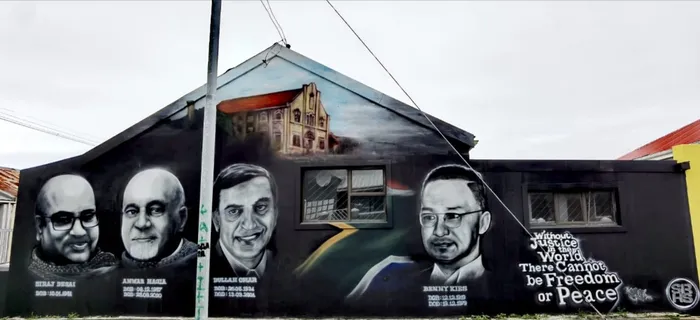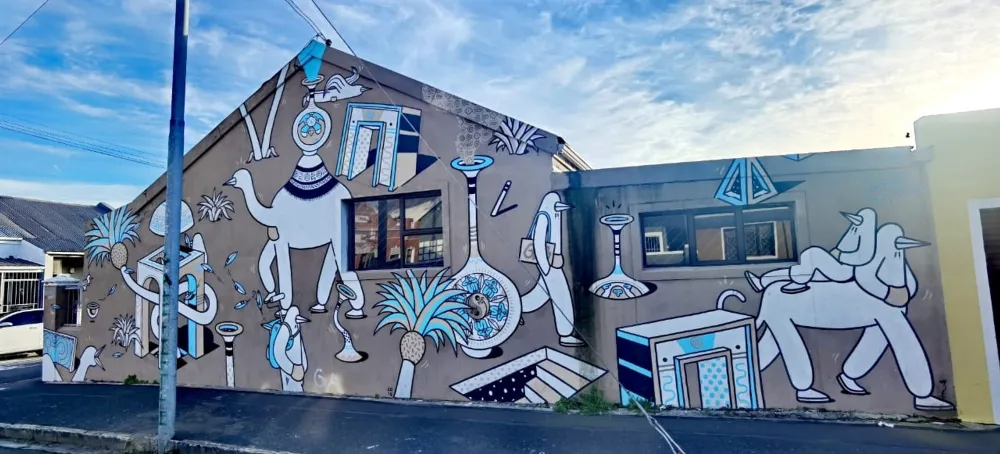Heritage group calls for rethink on Salt River murals

This mural by Natheer Hoosain and Nazeem Jardine depicts Judge Siraj Desai, businessman and community activist Anwah Nagia, former government minister Dullah Omar and political theorist and activist Ben Kies. Photographed by Anwar Omar.
Three new murals have appeared in Salt River that a local heritage society says better reflect the community than much of the art on the neighbourhood’s walls.
A heritage walking tour on Saturday took in the new murals that were commissioned by the Salt River Heritage Society (SRHS) under their new street art initiative, called the Community Arts Festival.
The SHRS says it wants murals to better reflect the history, culture and heritage of the area.
The mural on Suhail Wing-King’s house, on the corner of Pope and Kingsley streets, depicts Judge Siraj Desai, businessman and community activist Anwah Nagia, former government minister Dullah Omar and political theorist and activist Ben Kies. Painted by Natheer Hoosain and Nazeem Jardine, in August, it replaces a mural commissioned by the Baz-Art non-profit organisation, in 2018, under the theme “we need nature, nature doesn't need us”.
Mr Wing-King said the new mural better reflected the history of the area.
“The previous work done was reflective of the artist rather than the community, and the new mural depicts the true history of the Salt River community. It is important to note that when we have people coming into the community, the art murals on the wall should be associated with the community itself rather than unrelated to who we are.”
A second mural, by Robyn Pretorius and Nazeem Jardine, includes the image of former Banyana Banyana captain Desiree Ellis, and, according to Anwar Omar, the vice chairman of the SRHS, it represents the history of sport in the area and its role in social engagement and youth development.
“The third mural,” said Mr Omar, referring to a work depicting the Palestinian struggle from 1897 till now, “reflects our history of international solidarity with communities in the rest of the world that are subjected to racist and discriminatory policies, colonialism and social injustice and the denial of their basic human rights.”
It was painted by Nawawie Matthews with assistance from Tasneem Chilwan and Nazeer Jappie.
Mr Omar said very few of the approximately 140 murals throughout Salt River reflected the history, heritage and culture of the community and did not resonate with the historical experience of the residents.
“The SRHS is trying to change this narrative with the images we place on the walls, so that the community can relate to it,” he said.
Murals were a very effective way of reminding communities of historical events and history and heritage should not be distorted and commercialised in the area, he said.
The founder of Baz-Art, Alexandre Tilmans, said: “Once a mural has been painted, the wall belongs to the community. The main rule in street art is always to do better. So if one believes an artwork is better suited on top of some else’s, then a change or replacement can occur. This is the beauty of street art, it always evolves.
“All painted walls have a local story behind them, since they have been painted with an artist that shared his time with a homeowner and neighbours while painting. One needs to look beyond the colours and shape to discover the real story - this is the nature of art.”
Mr Tilmans said the Baz-Art festival had a different theme every year. The theme always needed to have a positive impact, trigger conversation, be local as well as applicable anywhere in the world, but it should not be political or religious.
“Each theme guided the artist in the conception of the mural, but one should remember that when you paint in public and on someone’s house, there are lots of conversations and dialogues with the homeowners and the neighbours prior to the actual painting. The artist knows very well the wall will belong to the community. The community should be able to understand and appreciate it.”
Mr Tilmans said if homeowners did decide to change or remove a mural at any time, “I would just urge the homeowner to think about the artist, the time they shared with the artist, the conversations they had with the artist and the economic impact it could have on the artist before removing an artwork.”
Every public artwork in Cape Town needs a permit, which includes the agreement between the homeowners, neighbours and the City.
“The permitting system helps guarantee that a painting will be appreciated when painted. However, a homeowner can always decide to change or remove a mural on the wall at any time,” said Mr Tilmans.
SRHS chairperson Dr Yusuf Lalkhen said: “Before we proceeded with selecting a piece of art and its location, we considered whether the art was relevant and would speak to the community. We engaged with the respective owners of the sites to explain to them our intention and consulted with the surrounding neighbours to get their approval. After that we sourced the appropriate artist for each intended mural and site.”
Mr Lalkhen said they wanted residents to reflect on the murals’ respective messages of social justice, the value of sport in a community, and international solidarity.
“In other words we want the art to deepen the understanding of values that hold a community together and promote its development,” he said.
At each mural site, there were speeches by Judge Siraj Desai, Dryden Street Primary School principal Stanton Smith and the Palestinian ambassador Hanan Jarrar.


